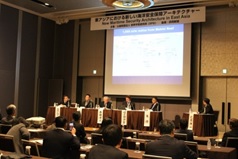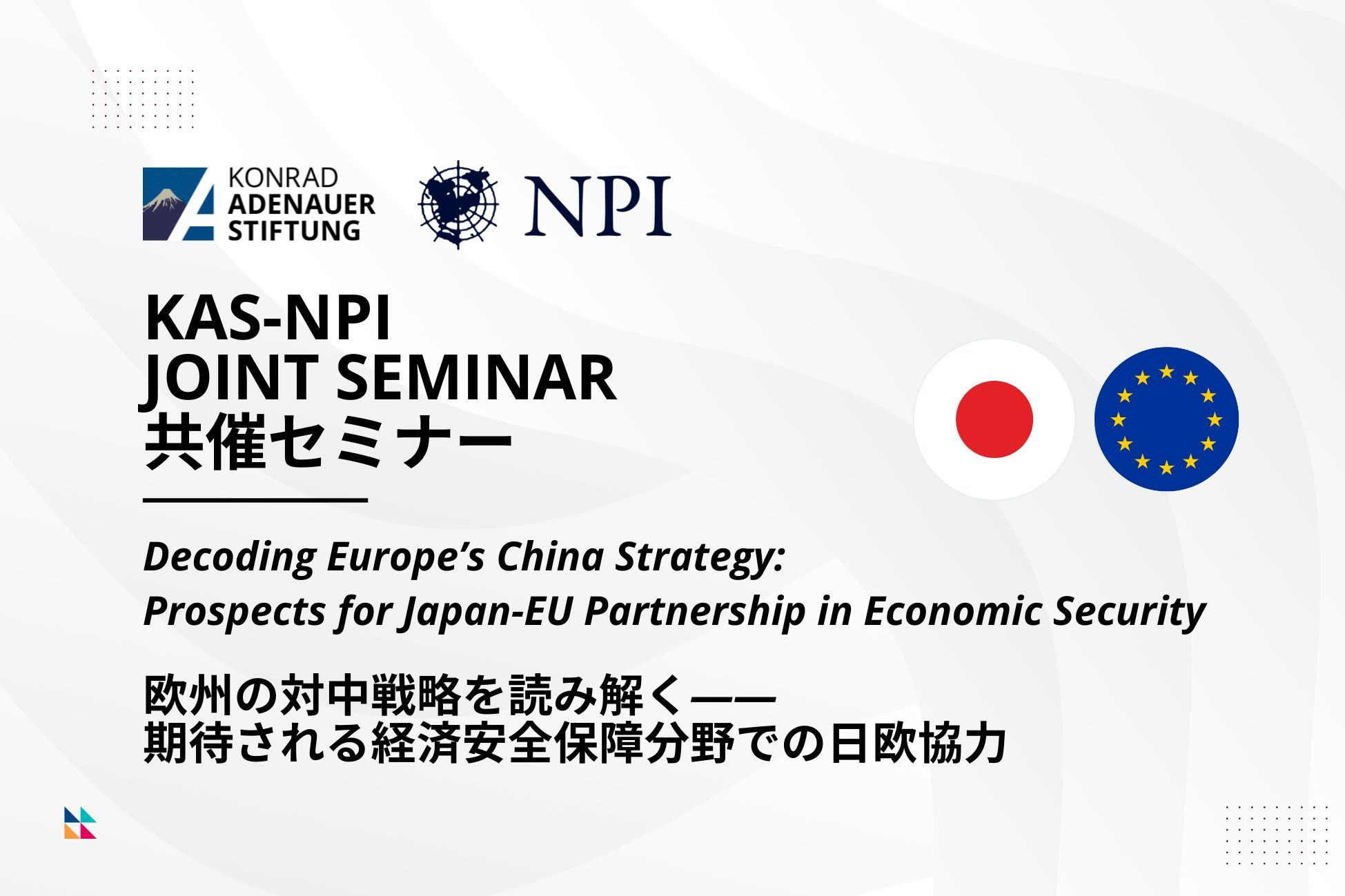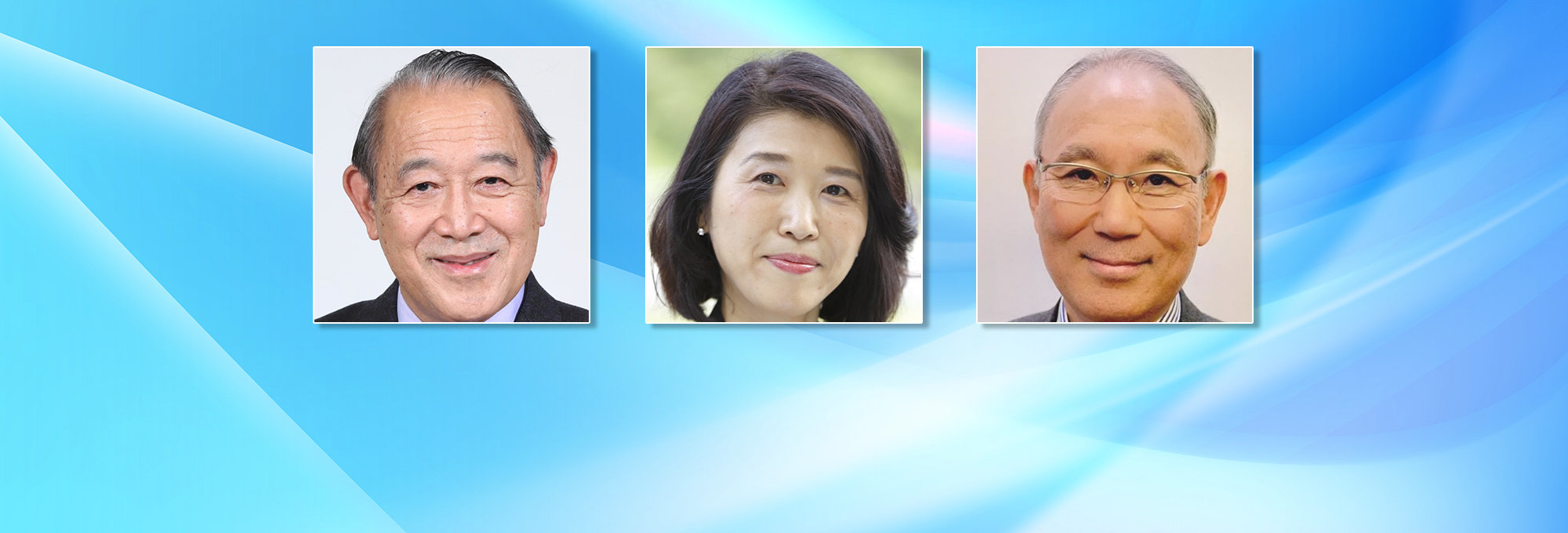2015/02/04
Symposium on New Maritime Security Architecture in East Asia
The Symposium on New Maritime Security Architecture in East Asia was held in Tokyo on January 30, 2015 with the participation of nine foreign experts from Southeast Asian countries, China, Taiwan, the U.S., and Australia. Along with the presence of more than 80 professional audience members, the experts had lively discussions.
 In his opening remarks, Mr. Ken SATO, President of IIPS, proposed the idea of an "Asian Maritime Organization for Security and Cooperation (AMOSC)," pointing out that there is no regional organization with maritime domain awareness, which is most urgently required for tackling the current situation. He stressed that the idea of the AMOSC would be a very timely proposal, given that the Japan-China summit meeting in November 2014 was followed by the recent Japan-China High-level Consultation on maritime affairs on January 22, and that this year would be the year of maritime cooperation between ASEAN and China.
In his opening remarks, Mr. Ken SATO, President of IIPS, proposed the idea of an "Asian Maritime Organization for Security and Cooperation (AMOSC)," pointing out that there is no regional organization with maritime domain awareness, which is most urgently required for tackling the current situation. He stressed that the idea of the AMOSC would be a very timely proposal, given that the Japan-China summit meeting in November 2014 was followed by the recent Japan-China High-level Consultation on maritime affairs on January 22, and that this year would be the year of maritime cooperation between ASEAN and China.
 In the first session, Dr. Shinichi KITAOKA, Executive Director of Research at IIPS and President of International University of Japan, served as moderator for the session entitled "Current Status and Views on Maritime Security Issues and Disputes in the East China Sea and South China Sea." The experts from the Philippines, Vietnam, China, Taiwan, and Japan respectively expressed their views.
In the first session, Dr. Shinichi KITAOKA, Executive Director of Research at IIPS and President of International University of Japan, served as moderator for the session entitled "Current Status and Views on Maritime Security Issues and Disputes in the East China Sea and South China Sea." The experts from the Philippines, Vietnam, China, Taiwan, and Japan respectively expressed their views.
Mr. Roilo GOLEZ, former Senator from the Philippines, emphasized the negative impact of China's current reclamation activities in the South China Sea islands on the regional and global balance of power.
Dr. ZHU Feng from Nanjin University, China stressed the importance of avoiding a security dilemma in the region by pointing out that both regional states as well as China are becoming more assertive on the maritime issues.
Dr. John Chuan-tiong LIM from Academia Sinica, Taiwan emphasized there would be no final solution to maritime disputes in the South China Sea without Taiwan's participation, so Taiwan must be recognized as a claimant state.
VADM Yoji KODA, former JMSDF Officer, Japan, referred to China's reclamation of Woody Island, Johnson South Reef, and Scarborough Shoal which would create a strategic triangle in the center of the South China Sea, thus leading to fundamental changes regarding the regional strategic landscape.
As a conclusion, Dr. KITAOKA wrapped up the discussions by emphasizing the importance of solving maritime disputes through calm discussions and consultations based on international law in a multilateral environment.
After the coffee break, Mr. Futoshi MATSUMOTO, Senior Research Fellow at IIPS, provided a detailed explanation on the idea of "AMOSC" based on the OSCE model.
He specified the central missions of the "AMOSC" as threefold: (1) Enhancing Maritime Domain Awareness, (2) Maritime Capacity Building, and (3) Maritime Confidence-Building Measures. The purpose of "AMOSC" is to prevent and better manage current maritime disputes in an orderly manner, thus contributing to building and sustaining peace and order on a mid- and long-term basis.
 In the second session, Mr. Ichiro FUJISAKI, Vice President of IIPS and former Ambassador to the U.S., served as moderator of discussions with the theme of the "Way Forward and Recommended Policies regarding Maritime Disputes in East Asia including a New Regional Maritime Architecture." The experts from Indonesia, Singapore, Malaysia, Australia, and the U.S. expressed their comments and opinions.
In the second session, Mr. Ichiro FUJISAKI, Vice President of IIPS and former Ambassador to the U.S., served as moderator of discussions with the theme of the "Way Forward and Recommended Policies regarding Maritime Disputes in East Asia including a New Regional Maritime Architecture." The experts from Indonesia, Singapore, Malaysia, Australia, and the U.S. expressed their comments and opinions.
Dr. Shafiah F. MUHIBAT from CSIS, Indonesia and Ms. Jane CHAN Git Yin from RSIS, Singapore shared some questions on the "AMOSC" proposal. They commented by saying that it might be better first to streamline the existing ASEAN architecture on maritime security rather than creating new one, and the need to better combine the AMOSC and the ASEAN centrality concept. In addition, they noted that Southeast Asians might hesitate to accept the idea if they are told to adopt any European centric model.
Dr. Balakrishnan R. K. SUPPAIAH, from Malaya University, Malaysia proposed the idea to start a more informal framework and develop it into a more formal one incrementally. To that end, he proposed the model of Pacific Economic Cooperation Council (PECC).
Dr. John LEE, from Sydney University, Australia described the three conditions for the success of the proposal: (1) it must reflect the power distribution of the system, (2) it must recognize the geostrategic reality, and (3) the cost of non-compliance must be high. He emphasized the importance of an inclusive framework in this region.
Lastly, Dr. Patrick CRONIN from the Center for the New American Security (CNAS), U.S. stressed the necessity for China to respect the rule of law in the maritime arena and commended the importance of adopting an inclusive framework such as the AMOSC in this region.
IIPS will compile the report on the desirable "New Maritime Security Architecture" based on our "AMOSC" proposal, further reflecting the comments and opinions expressed by the experts at the symposium by the end of March.
With the upcoming report, IIPS is determined to continue to disseminate the idea on maritime security architecture including the AMOSC to officials and the public in regional countries and beyond with a view to promoting a framework to safeguard peace and order in the region.


*For the official report and policy paper released by IIPS after the conference:
▶IIPS (Institute for International Policy Studies) Policy Paper:
"Asian Maritime Organization for Security and Cooperation" (AMOSC) -- Initial Report on Conceptual Framework --





